Instituto Cultural Minerva
Institute of Brazilian Issues
The George Washington University
Washington, DC
An Overview of Bilateral Financing in Brazil
By Gérson de Sousa Kyt
The Minerva Program – Spring 1999
CONTENTS
- Introduction
- Bilateral Financing in Brazil
- Background
- The General Coordination of Bilateral Financing of the Ministry of Planning
- Main Partners
- Global Environment Facility – GEF
- PPG – 7
- The Evolution of the Bilateral Cooperation (95-98)
- Activities in 1995
- Activities in 1996
- Activities in 1997
- Activities in 1998
- Portfolio of Projects
- Disbursements (95-98)
- Pipeline of Projects: Prospects
INTRODUCTION
The aim of this paper is to provide an overview of the bilateral financing in Brazil with special emphasis on the last 4 years. The covered period coincides with the first mandate of President Fernando Henrique Cardoso.
Since the so called Real Plan, the willingness for bilateral agencies to provide financing for governmental projects in Brazil has increased considerably, and the country has benefited from such a opportunity.
This paper will be based upon several reports produced by the General Coordination of Bilateral Financing and all data were gathered from the databases built and maintained by the Secretariat of International Affairs of the Ministry of Planning and Budget of Brazil.
BILATERAL FINANCING IN BRAZIL
The Bilateral Financing in Brazil nowadays has been conducted by the Secretary of International Affairs of the Ministry of Planning, more specifically by the General Coordination of Bilateral Financing.
- BACKGROUND
Historically, the Bilateral Area has suffered several changes within the Brazilian Government. By early 80’s, during President Figueiredo’s mandate, the Bilateral Financing Area was subordinated to the SUBIN – Secretariat of International Affairs of SEPLAN/PR – Secretariat of Planning of Presidency of Republic. By mid 80’s, during Presidente Sarney’s term, the Area was transferred to the SAIN/MF – Secretariat of International Affairs of Ministry of Financing, close to the Multilateral Area. By that time, the bilateral activities were restricted to negotiation of loan agreements with just one agency, the "Kreditanstalt für Wiederaufbau" – KfW, from Germany.
Still under President Jose Sarney’s term, as a consequence of the return of the Multilateral Area to the SEPLAN/PR, two committees were created in order to analyze the requests for external financing for public projects: a) the "Comissão de Financiamentos Externos" – COFIEX, Committee for External Financing, with the role to analyze requests for financing from multilateral agencies, presided by the Deputy Ministry of SEPLAN/PR, and b) the "Comissão de Créditos Externos" – COCEX, Committee for External Credit, with the role to analyze projects involving financial cooperation from foreign governmental institutions or foreign governments, headed by the Deputy Ministry of Finance.
When the Ministry of Economy, Finance and Planning – MEFP, was created, in 1990, the Bilateral Area was incorporated by the Department of International Affairs – DEAIN – of the National Secretariat of Planning – SNP, similarly to the Multilateral Area.
At DEAIN, the Bilateral Area was organized as the Coordination of Bilateral Projects, subordinated to the General Coordination of External Financing. The new institutional arrangement brought about the need for a new approach for the Brazilian Government to analyze and approve requests for external financing. As a result, COFIEX was changed by the Decree 99.941, of May/07/90. The committee became since then responsible for analyzing projects to be submitted to both bilateral and multilateral sources.
Not only institutional changes occurred, but also physically the Bilateral Area changed quite a lot, which contributed for a reduction in its structure. Consequently, the "institutional memory" was seriously affected. The activities of tracking projects became somehow impossible, and some problems with very difficult solution emerged.
The early 90’s also represented to the Bilateral Area an expansion in external sources of financing, specially with Japanese agencies: Export-Import Bank of Japan – EXIMBANK, The Overseas Economic Cooperation Fund – OECF and Japan International Cooperation Agency – JICA. In 1991, four loan agreements were signed with OECF, in a total amount of US$ 478,9 million. In 1992 the EXIMBANK of Japan signed two credit lines with BNDES in a total amount of US$ 300,0 million.
By the end of 1992, with the new Secretariat of International Affairs of the Secretary of Planning, Budget and Coordination of the Presidency of Republic – SEAIN/SEPLAN/PR, the General Coordination for Bilateral Financing was created, having two distinct sectors: Negotiations and Accompaniment. The new structure was strengthened by more technical positions and with a new databases, but still not enough to face its necessities.
The main tasks carried out during the period 93-94 were to recover the databases, improve the portfolio accompaniment and the incorporation of the coordination, studies, negotiation and accompaniment of environmental projects as a consequence of GEG – Global Environment Facility creation during ECO – 92. In 94, SEAIN/SEPLAN/PR published the External Financing Manual. The document contains the basic orientation for organizations and entities interested in having either a bilateral or multilateral financing.
The year of 1994 was very important to the Area, since the signature of two loan agreements with Japan, in a total amount of US$ 386 million, consolidated that country as the main source of bilateral financing for Brazil. JICA financed PRODECER III (US$ 91,8 million), and OECF the "Baía da Guanabara" Recuperation Program in a amount of US$ 294,2 million.
Under the "Plano Real" context, in July 1994, the COFIEX works were temporarily suspended, restricting the activities related to external financing to the activity of following-up executing projects.
By the very end of 1994, the situation regarding to bilateral financing and donations from bilateral sources to environmental projects were as following:
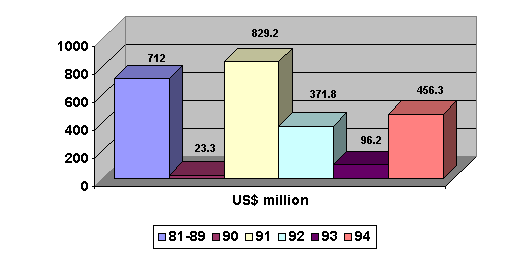
- THE GENERAL COORDINATION OF BILATERAL FINANCING
The General Coordination of Bilateral Financing –CGFIB is the area of the Secretariat of International Affairs responsible for coordinating the process of preparation, evaluation, negotiation and execution of projects and programs, within the public sector, which demand financing, credit insurance or interest rates equalization, from foreign governmental institutions, having the Republic Federative of Brazil as borrower or as guarantor. Therefore, the CGFIB acting starts once a project or a program is submitted to the Committee of External Financing – COFIEX, and continues during the process of negotiation of the basis for the loan agreement, insurance and equalization of interest rates.
Besides, CGFIB has also has achieved excellent results trough systematically monitoring projects and programs, which would end only at the project/program conclusion. In order to avoid any difficulty resulting from delays of payments to financing agencies, the General Coordination has acted supporting the Secretary of National Treasury in its role.
- MAIN PARTNERS
The main partners of Brazil for bilateral financing have been so far the following:
|
Japan |
JEXIM - Export Import Bank of Japan |
|
|
OECF - Overseas Economic Cooperation Fund |
|
|
JICA - Japan International Cooperation Agency |
|
|
|
Germany |
KfW - Kreditanstalt fur Wiederaufbau |
|
|
D/A Bank - Deutsche Aussenhandels Bank |
|
|
|
|
Italy |
I.B. San Paolo |
|
|
Medio Credito Centrale |
|
|
|
|
Hungary |
METRIMPEX |
|
|
MEDICOR |
|
|
EXTERNBANK |
|
|
|
|
Spain |
FOCOEX |
|
|
|
- GLOBAL ENVIRONMENT FACILITY – GEF
Established by the middle of 1991, it is faced with the organization and coordination of the efforts to protect the global environment.
It can be defined as a financial mechanism managed by the World Bank which is responsible for granting funds in favorable conditions to the private and public sectors of the member countries. Such resources has been directed to the following areas: Climate Changes, Biological Diversity, International Waters and Ozone Layer.
It was decided during ECO-92 that it would be necessary to restructure the program with an operational phase starting in 1994.
The Secretary of International Affairs of the Ministry of Planning and Budget is the focal point of GEF for financial cooperation and it is responsible for inviting other areas of the Government to make the final decision regarding to the merit of the applications. Besides, SEAIN is responsible for coordinating the negotiation related to the contracts.
GEF’s projects have been divided in 3 categories according to amount of facility: Long Term (above US$ 1 Million), Medium Sized (between US$ 350,000 and US$ 750,000) and Small Projects (donations up to US$ 50,000). There is the PDF (Project Development Facility) which consists of advance payment up to US$ 1 Million created in order to facilitate the Long Term Projects.
GEF has three implementing agencies: UNDP (United Nations Development Program) located in Brasília, UNEP (United Nations Environment Program) located in Nairobi – Kenya, and the World Bank.
So far, the majority of projects financed by GEF have been related to bio-diversity. Brazil is the third country to receive resources from the Fund.
- PILOT PROGRAM FOR THE BRAZILIAN RAIN FOREST – PPG-7
The Pilot Program for the Brazilian Rain Forest, PPG-7, is a collection of integrated projects of the Brazilian Government and the Brazilian Society with technical and financial support provided by the international community.
It aims basically to maximize the environmental benefits of the rain forests and to preserve them consistently with the country’s development policy, throughout the implementation of sustainable development process.
This program was established when the seven richest countries (G-7) made the offer during its meeting in Houston in July, 1990. The European Community and the World Bank were than pointed as the Brazilian liaison.
Brazil prepared its proposal in how to invest the resources and presented it in London in 1991. The proposal consists of a general program up to US$ 1,5 Billion, with a pilot phase of US$ 250 Million.
The projects must be developed within 4 subprograms: Management and Conservation Units for Natural Resources, Science and Technology, Natural Resources Policy and Demonstrative Projects.
The Ministry of Environment is the focal point within the Brazilian Government, whereas SEAIN is the area responsible for the negotiation.
The main donators are: RFT (Rain Forest Trust Fund – controlled by the World Bank), KfW (Germany), CEC (European Community), ODA (Overseas Development Agency – Japan), GTZ (German Technical Cooperation) and USAID.
Some ongoing projects being executed with resources from other agencies acting in the same sector were incorporated to the Program and have been called since then as Associate Bilateral Projects.
By the end of 1998, the total amount of donations reached US$ 102,2 Million for approved projects and US$ 160 Million for projects under execution.
2.6 THE EVOLUTION OF THE BILATERAL COOPERATION (95-98)
2.6.1 ACTIVITIES IN 1995
The restart of COFIEX’s activities by the first half of 1995 and the consistent results of "Plano Real" made 1995 a very demanding year to the Bilateral Area.
Aiming to improve the methodology of analyzing the Consulting Letters, COFIEX created in 1995 the called "Grupo Técnico de Exame de Cartas-Consulta" – GTECC, Technical Group for Consulting Letters Examination, in order to provide the appropriate forum for clearing and improving technical details of the projects to be submitted to COFIEX. During GTECC’s meetings, the borrowers are invited to present and defend its applications, receiving feed-backs, comments and suggestions from the technicians representing the various agencies with seat at COFIEX. The experience showed to be very fruitful in terms of improving the consistency of the projects to be analyzed by COFIEX.
The so called G-7 countries increased in 1995 their contacts with the Brazilian authorities aiming to expanding their bilateral financing operations, shifting the stagnation process which had started in 1982 with the Brazilian external debt crisis. Similarly, positive signs were emitted by the "Asian Tigers".
Regarding to the G-7 countries, the main events in 1995 were related to Germany and Japan, the two most important sources of bilateral financing.
The Brazil-Japan relationship improved a lot during 1995. The restart of the conversations between the two countries was characterized by the presentation in May/95 of the priority list of projects to be financed by the EXIMBANK of Japan. The list was present to the Senior Executive Director of JEXIM during his mission to Brazil, having that authority announced by the time that the bank would send soon a mission for macroeconomics assessment to Brazil, recognizing that the Brazilian Government hadn’t, by that time, any intention to celebrate any agreement with the IMF, which would be a previous condition to reopen the concession of loan from the Japanese agency to Brazil.
From July, 2 to 8, two missions from EXIMBANK were sent to Brazil. One for Macroeconomics Analysis, headed by the Deputy General Director of the Department of Analysis of Economic Policy, and other from the Loan Department III, headed by its General Director. The SEAIN/CGFIB arranged meetings for the two missions with several Brazilian authorities, including the Minister of Planning, the Minister of Finance, the Presidents of the Central Bank and Bank of Brazil and with some Secretaries from the Ministry of Foreign Affairs, the Ministry of Labor, the Ministry of Trade and Industry and the Ministry of Social Security, as well as with some Directors and the technical body of the Central Bank. The support from the agencies being visited contributed to a great extent to the amount of data collected by the two missions. Additionally, the priority list of projects was revised with SEAIN/CGFIB, and a new version was released by September 1995, since both parts have agreed such a list to be dynamic.
Concerning to The Overseas Economic Cooperation Fund – OECF, a mission headed by its Vice President visited Brazil in July 1995, aiming to discuss the possibility of the Fund to provide financing to some Brazilian projects, and also to solve some pending issues regarding to the following projects: Recuperation of Tiete River (under negotiation) and Port of Santos Modernization Project (being executed).
A list including 23 projects was presented by that time to OECF, following the same approach applied to the JEXIM.
A further step to improve the relationship with the Japanese Government was taken when the Minister of Foreign Affairs and the Minister of Finance visited Tokyo in 1995, which allowed the reopening of "untied loans" to Brazil.
By the end of September 1995, a SEAIN/CGFIB mission went to Japan in order to present technical details of some projects included in the priority lists previously agreed with the EXIMBANK and OECF.
One month later, in October, a governmental mission from OECF, compose by representatives from the four Ministries integrating the executive board of the fund. The aim of the mission was to detail aspects related to some projects selected from the priority list. The event was organizes as never before, giving to the candidates the opportunity to present, debate and explain their projects. In total, 12 projects were analyzed by the governmental mission, as following:
|
PROJECT |
BORROWER |
AMOUNT |
|
Electricity Supply to Vila do Conde |
CVRD |
104,4 |
|
Itajaí-Açu Basin Flood Prevention |
Santa Catarina State |
294,1 |
|
Wind Power Plants of Ceará State |
Ceará State |
60,0 |
|
Environmental Sanitation Project of Paraná State |
Paraná State |
210,0 |
|
Environment Preservation Program of Tocantins |
Tocantins State |
80,2 |
|
Enviroment Sanitation Program of "Baia de Todos os Santos" |
Bahia State |
85,0 |
|
Environmental Recuperation of Jacarepaguá Basin |
Municipality of Rio de Janeiro |
200,0 |
|
Irrigation Program of Jequitinhonha and Pardo Rivers in Minas Gerais State |
Minas Gerais State |
48,0 |
|
Sanitation Program of São Luis Island |
Maranhão State |
162,0 |
|
Rural Telecommunication Project of Goiás e Tocantins |
TELEGOIÁS |
123,0 |
|
Water Resources Conservation and Revitalization Program – "PROAGUA" |
Republic Federative of Brazil |
800,0 |
|
TOTAL AMOUNT |
|
2.166,7 |
The Brazilian Government would like to receive financing from OECF for other projects rather than those related to environment. Therefore, during the Japanese mission to Brasilia, SEAIN/CGFIB tried to show that although Brazil has a per capita income over to US$ 2,500.00, which is the limit posed to a country to be eligible to receive low cost financing, the Brazilian needs are enormous, since the country faces a very big gap between poor and rich areas and also between urban and rural areas in terms of economic and social development. Consequently, some regions would still remain below the defined limit for new concessions.
As the Brazilian Government expected, the Governor of The EXIMBANK of Japan announced during his meeting with Minister Jose Serra in October that the institution would reopen the called Untied Loans to Brazil. The announcement was understood as a prize to the effort coordinated by the MPO in order to provide consistent data to make possible such a decision by the Japanese authorities.
To conclude the "in loco" assessment process, missions of OECF and EXIMBANK were sent to Brazil in December/95.
The OECF mission analyzed deeply six projects, as following:
1) Environmental Sanitation Project of Paraná State
2) Itajaí-Açu Basin Flood Prevention
3) Enviroment Sanitation Program of "Baia de Todos os Santos"
4) Wind Power Plants of Ceará State
5) Environment Preservation Program of Tocantins
6) Electricity Supply to Vila do Conde
The first three projects mentioned above showed to be those which would fit better to OECF guidelines, since they are more clearly related to the environment.
The EXIMBANK mission, by its turn, carefully analyzed the following five projects:
- Metropolitan Train of Fortaleza
- State Road Program of Tocantins
- Modernization of São Paulo-Curitiba-Florianópolis Highway
- BNDES Multisector Credit Program
- Project Alunorte
The Project Alunorte, which would imply to extend the company’s debts, differs from the others as it can be classified as "investment loan", since it is a "joint venture" including Japanese companies.
The reduced staff of CGFIB did not allow its technicians to take part in all assessments as it would be strongly recommended. Therefore, it was necessary to set priorities such as to be present at the beginning and at the conclusion of the works or even getting more involved with projects considered to be the more critical ones.
Regarding to the relationship with Japan was also characterized by the signature of 4 Loan Agreements, including two credit lines to the Bank of Brazil, which did not require COFIEX approval:
|
Project |
Borrower |
Agency |
US$ Million |
|
Bank Loan |
Bank of Brazil |
EXIMBANK |
100,0 |
|
Bank Loan |
BNDES |
EXIMBANK |
100,0 |
|
Duplication of Capacity of CENIBRA |
Vale do Rio Doce |
EXIMBANK |
200,0 |
|
Rio Tietê Revitalization Project |
State of São Paulo |
OECF |
371,7 |
Concerning financial cooperation, the relationship between Brazil and Germany remarkably improved in 1995 as well. The CGFIB coordinated an effort aiming to demonstrate the importance of increasing the amount of resources available to Brazil in order to keep Germany as the second biggest source of external investment in Brazil during the 90’s. Besides, CGFIB requested more flexibility from the German side regarding to the preceding conditions for authorizing signature and disbursements for new loan agreements, based on the strong reduction in pending repayments with that government. The result achieved by the "Plano Real" justify the two requests posed by CGFIB.
Four new intergovernmental agreements were signed by the two governments and confirmed by the Congress. Three of them are related to donations to the "Rain Forest Protection Pilot Program", PPG-7, and one donation to the transportation sector, as following:
|
Project |
Borrower |
Agency |
US$ Million |
|
Project for Demarcation of Native’s Land |
Federal Government/MMA |
KfW/PPG-7 |
16,6 |
|
Demonstrative Projects/PDA |
Federal Government/MMA |
KfW/PPG-7 |
11,7 |
|
Paraná’s Atlantic Forest Protection |
State of Paraná |
KfW |
11,9 |
|
RJ-Campinas-SP Transportation Corridor Studies |
Federal Government/MT |
KfW |
8,0 |
|
Total |
|
|
48,2 |
In total, 5 Loan Agreements and/or Financial Cooperation were actually signed with KfW during 1995, as following:
|
Project |
Borrower |
Agency |
Donation
US$ Million |
Financing
US$ Million |
|
Project for Demarcation of Native’s Land |
Federal Government/MMA |
KfW/PPG-7 |
16,6 |
- |
|
Demonstrative Projects/PDA |
Federal Goverment/MMA |
KfW/PPG-7 |
11,7 |
- |
|
Basic Health Program in Ceará |
Federal Government/MS |
KfW |
1,0 |
8,0 |
|
Sanitation Program of Pernambuco |
Pernambuco State |
KfW |
1,3 |
8,7 |
|
Flood Control of "Rio dos Sinos" |
Rio Grande do Sul State |
KfW |
- |
13,9 |
|
Total |
|
|
39,6 |
30,6 |
The Loan Agreements related to Paraná’s Atlantic Forest Protection and RJ-Campinas-SP Transportation Corridor Studies were left to be signed in 1996.
As a result of the German interest to improve the relationship between the two countries, the new modality of credit from KfW was presented during the Intergovernmental Consultation, which occurred in December 12-14, 1995. This new kind of financing cooperation if provided by Germany to Brazil would combine resources from the federal budget of Germany with resources taken by KfW from the capital market, allowing interest rates ( 3 to 4 %) lower than those applied to commercial credit lines.
This new modality would finance infrastructure projects (telecommunication, energy, transportation, environment technology, etc), as well as manufacturing sector projects. The total amount previously expected was of DM 50 million, which would be directed to environment project executed by FINEP with financing from IDB.
The beginning of a new promising phase of the German-Brazilian relationship was emphasized by the visit of the German President and the Ministry of Economic Cooperation and Development to Brazil.
In 1995 six donation contracts were negotiated with the World Bank under PPG-7, in a total amount of US$ 97,9 million. During the same period, CGFIB presented to GEF through UNDP seven application for projects expecting to receive donations in a total amount of US$ 102,4 million, as following:
|
Project |
Entity |
Agency |
Donation |
|
Brazilian National Climate Change |
Federal Government/MCT |
GEF |
1.5 |
|
"Estratégia Hidrogenio Eletrolítico |
Federal Government/MME |
GEF |
3.8 |
|
"Sistema Cogeração Energia Óleo Dendê" |
DENPASA |
GEF |
0.9 |
|
"Proteção Biodiversidade Ecossistema Mangues" |
Federal Government/MMA |
GEF |
64.8 |
|
PROBIO |
Federal Government/MMA |
GEF |
30.0 |
|
"Projeto Biodiversidade Juruena" |
Pro Natu |
GEF |
0.4 |
|
"Projeto Integrado Biomassa" |
IPT |
GEF |
1.0 |
|
Total |
|
|
102.4 |
By the end of 1995 the total amount of bilateral financing and donations for environmental projects during the decade had the following configuration:
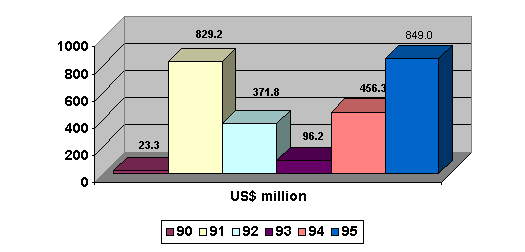
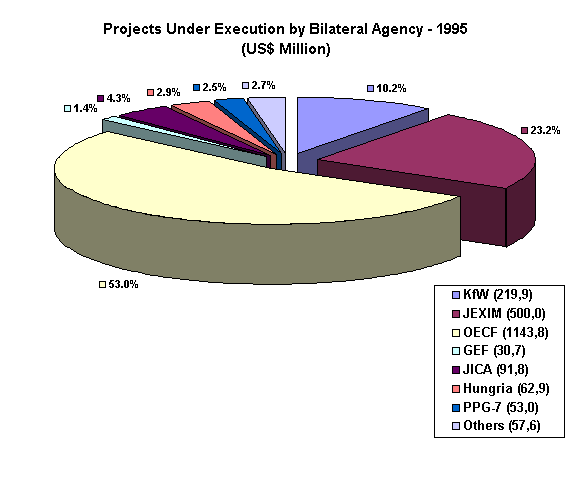
The total amount of projects under execution by that time was US$ 2,159.7 million, distributed according to the bilateral agencies as it follows:
- ACTIVITIES IN 1996
In order to improve the project portfolio performance, it was implemented in 1996 the semiannual monitoring meetings with the KfW. Two meetings occurred in 1996, one of them in Brasilia and the other in Germany, when important pending problems were sorted out.
Similarly, also with the OECF, semiannual monitoring meetings occurred, and two meetings which took place in Brasilia showed to be very useful for improving the execution of the four projects been monitored: Port of Santos, Jaíba II, Revitalization of "Baía da Guanabara" and Revitalization of Tiete River. During the meeting occurred in October, CELG – Electricity Company of Goiás – received significant congratulations from OECF for its performance with the Rural Electrification Program.
The same sort of monitoring meetings were proposed to the EXIMBANK of Japan as a result of the new loan agreements being negotiated in 1996, and they are expected to take place from 1997 on.
The total of bilateral financing and donations actually negotiated and agreed in 1996 reached the record amount of US$ 2.194,00 million. 20 projects were granted with bilateral financing, six of them were granted with donations in a total amount of US$ 77,5 million. 14 out of the 20 projects were left to be signed by 1997 since internal final steps had to be taken by the Secretary of Treasury aiming to gain the Senate approval.
Bilateral Financing in 1996 – Signed Agreements (US$ Million)
|
Project |
Agency |
Total
Cost |
Bilateral
Financing |
|
Recuperation of the Water Supply System in Santa Catarina |
KfW |
10.0 |
6.7 |
|
Rural Electrification Program of Pernambuco |
KfW |
21.3 |
10.0 |
|
Electricity Supply of "Vale do Jequitinhonha – MG" |
KfW |
33.3 |
13.3 |
|
RJ-Campinas-SP Transportation Corridor Studies |
KfW |
8.7 |
8.0 |
|
PROBIO |
GEF |
48.0 |
30.0 |
|
Natural Resources Policy Project |
PPG-7/KfW |
29.6 |
24.8 |
|
Total |
|
150.9 |
92.8 |
Bilateral Financing in 1996 – Negotiated Agreements (US$ Million)
|
Project |
Agency |
Total
Cost |
Bilateral
Financing |
|
Global Plan for Itajai-Açu Basin |
OECF |
290.30 |
174.20 |
|
Wind Power Plant in Ceará |
OECF |
100.00 |
60.00 |
|
Environment Sanitation Program of Paraná |
OECF |
392.60 |
234.50 |
|
Environment Sanitation Program of Salvador and Suburbs |
OECF |
440.00 |
78.20 |
|
Metropolitan Train of Fortaleza |
EXIMBANK |
320.00 |
268.00 |
|
Tocantins State Road Program |
EXIMBANK |
219.48 |
48.00 |
|
BNDES Multi Sector Credit Program II |
EXIMBANK |
600.00 |
300.00 |
|
SP-Ctba-Florianopolis Highway Duplication Project |
EXIMBANK |
1,222.00 |
450.00 |
|
ALUNORTE Project (CVRD) |
EXIMBANK |
200.00 |
200.00 |
|
Sanitation Program II of Bahia |
KfW |
13.70 |
9.00 |
|
Improvement of Electricity Supply in Sergipe |
KfW |
20.00 |
10.00 |
|
"Mata Atlantica" Preservation Project |
KfW |
19.80 |
12.00 |
|
Metropolitan Railway Project of São Paulo |
FOCOEX/Spain |
300.00 |
255.30 |
|
Amazon Forest Management Support Project - FLONAS |
PPG-7 |
8.40 |
2.00 |
|
Total |
|
4,146.28 |
2,101.20 |
The 20 projects granted in 1996 with bilateral financing were distributed according to the source of financing as following:
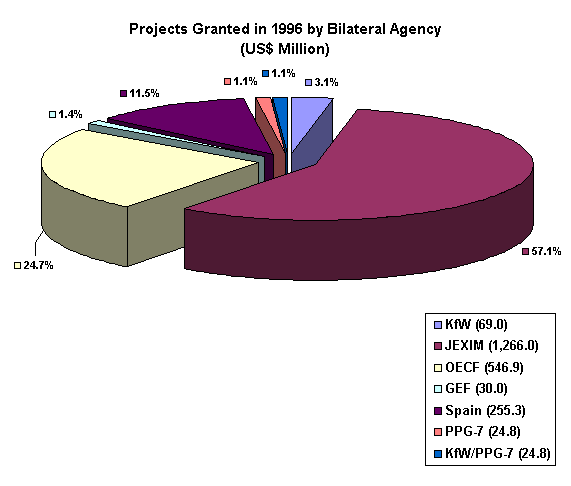
It was of great importance to the relationship between Brazil and Japan the visit of the Brazilian President to that country in March 1996. At that time the Ministry of Planning, the Ministry of Communications and the Ministry of International Affairs also visited Japan. During the visit, OECF and the EXIMBANK of Japan confirmed their offer to finance 9 projects in Brazil. Besides, the visit helped stimulate the relationship between the private sectors.
Similarly important and highly significant were the visits of the Japanese Prime Minister and of the President of OECF next July, showing the priority given by that country to the bilateral relationship with Brazil.
As it had occurred in the previous year, the JEXIM sent in 1996 to Brazil the mission for macroeconomics analysis, which allowed the surpassing of the condition imposed traditionally by that bank since new financing would only be possible within an agreement with IMF.
The reopening of the called "untied" loan from the OECF and the EXIMBANK of Japan allowed a big jump in the total amount from that country to Brazil up to US$ 1,812.90 million in 1996.
Based on the economic stability in Brazil by 1996, it was possible to SEAIN/CGFIB to negotiate and achieve much better financial and legal condition with the two Japanese institutions, as following:
- Commitment Fee: reduced to 0.25% for the new contracts with the EXIMBANK (the GTC – General Terms and Conditions of that bank pointed to 0.50%). This sort of fee has not been required by OECF.
- Interest Rates on Late Payments: reduced to 1% for both institutions (the GTC of the EXIMBANK requires 2% and of OECF 3% per year).
- Expenses related to contracts with the EXIMBANK: it was possible to Brazil to save up to US$ 450 thousand in 1996 on such expenses.
- Legal improvements: the Arbitration Principle and an adequate "pari-passu" were introduced.
It is important to remember that a series of small improvements were also achieved reflecting directly in the execution of projects being financed by the Japanese Government. Just as an example it worth to mention the since than possible retro financing of projects being co-financed by IDB or World Bank.
The negotiations with the EXIMBANK of Japan took a little long since for the first time "untied" loans to States with the Federal Government as guarantor had been negotiated. It was easier with OECF since most of the main pending issues had been previously sorted out when negotiations took place in 91, 94 and 95.
In June 28, 1996, the Secretary of International Affairs of the Ministry of Planning presented the newly revised List of Priority Projects (future pipeline) requiring financing from the JEXIM and from the OECF. The two lists were divided in group A and B reflecting the current stage of the feasibility studies been conducted for all projects. To the EXIMBANK 12 projects were submitted in a total amount of US$ 1,466 million being required. The list submitted to OECF included 14 projects requiring US$ 1,867 million from the Japanese institution.
The lists presented the guidelines of the Brazilian Government to discuss the 1997 pipeline of projects, and also included some projects to be discussed in 1998. Still, the lists could be considered dynamic, permitting new projects to be included, excluded or reclassified according to the evolution of bilateral talks and the studies related to the projects.
Also the bilateral relationship with Germany reached remarkable results in 1996. The German Prime Minister visited Brazil in September and declared that they have treated the country as a differentiated and privileged partner. By the second semester of 96, Hermes, the German insurance institution for exports upgraded Brazil from group 4 to group 3, what means a reduction in roughly 30% on the insurance premium paid by the country. The Ministry of Economic Cooperation of Germany announced, by the time, that Brazil could since them account also with "Conjugate Financing". Initially, this new modality would be possible for projects of Telecommunication sector and for industrial equipment aiming to reduce air pollution. This kind of financing is composed of resources from the public budget up to 50% and from the private sector to complement. The first portion has a 40 years period, including a 10.5 years grace period and interest rate of 0.75%. The portion from the private sector would be for 10 years, including 5 years grace period, and interest rate around 8%.
The monitoring meeting faced to the projects approved by KfW but still to be signed up allowed the solution of several problems. Therefore, 5 projects were signed in 1996 reaching the amount of US$ 62,8 million, including a total amount of US$ 32,8 million as donations. Adding to the figures 3 contracts already negotiated but with the signatures being postponed to 1997, we see that 1996 showed to be the best year during the 90’s as the bilateral cooperation with KfW reached the total amount of US$ 93,8 million, almost two times bigger than in 1995.
Regarding to FOCOEX of Spain, the negotiation of the loan agreement to the Metropolitan Railway Project of São Paulo in a total amount of US$ 255,3 negotiated in 1996 reopened the bilateral cooperation between the Brazilian and Spanish Government.
Some comments has to be done on the environmental projects in 1996. In spite of Brazil had submitted several projects to the Global Environment Facility – GEF, only project PROBIO was granted during that year. In order to disseminate the GEF, SEAIN/CGFIB promoted in 96 a seminar including, besides the Federal Government, the Secretaries of Environment of the States, Public Companies, Non-Governmental Organizations, Private Sector and Universities.
The biggest portion of the resources available to PPG-7 continued to come from the KfW of German. Some minor portions came from the Rain Forest Trust Fund – RTF and from the Commission of European Community – CEC.
To sum up, if we add the total amount negotiated in 1996 (US$ 2,194.00 million) and the amount contracted in the previous year (US$ 849.00 million), it is possible to conclude that during the first half of President Cardoso’s mandate the bilateral financing to Brazil was 70% bigger than in the previous 5 years.
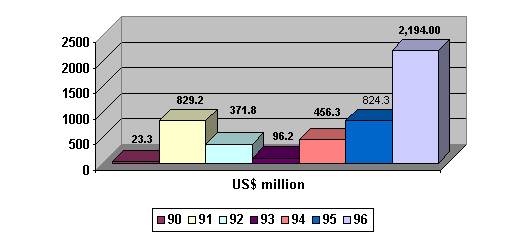 By the end of 1996 the total amount of bilateral financing and donations for environmental projects during the decade had the following configuration:
By the end of 1996 the total amount of bilateral financing and donations for environmental projects during the decade had the following configuration:
The total amount of projects under execution by that time was US$ 1,900.5 million, distributed according to the bilateral agencies as it follows:
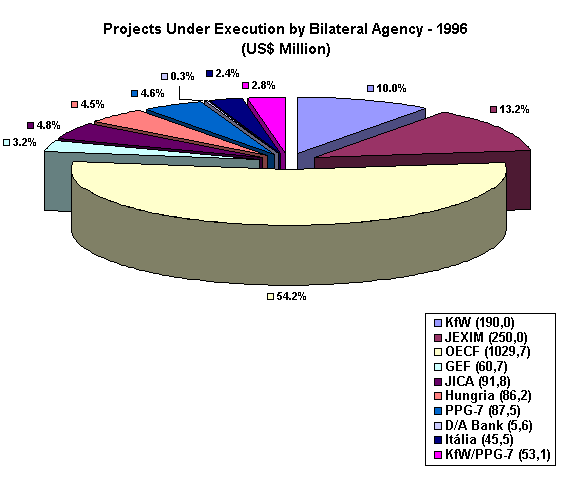
2.6.2 ACTIVITIES IN 1997
As in the previous year, the monitoring meetings with KfW and OECF continued to occur in 1997. Similarly, since the signature of the Memorandum of Understanding between the Brazilian Government and the EXIMBANK of Japan in May 1997, the same approach for monitoring ongoing projects were introduced to the referred bank. The first semi-annual monitoring meeting with JEXIM took place in Brasilia in September of the same year showing, as usual, remarkable results.
It was possible in 1997 to conclude all the tasks for the signature of 9 loan agreements which had been negotiated still during 1996, in a total amount of US$ 1,395.43 million of bilateral financing. Notwithstanding, for the other 4 projects already negotiated in 1996, in an amount of US$ 425.10 million, it was not possible to conclude all the pending issues during 1997.
The bilateral financing reached the total amount of US$ 1,435.40 million in 1997, as following:
- Contracts negotiated and signed: US$ 64.47 million.
- Contracts only negotiated during the year: US$ 1183.50 million.
- Contracts being negotiated: US$ 182.73 million.
- Financing for new projects and donations approved by the agencies: US$ 1,004.70.
Bilateral Financing in 1997 – Contracts Negotiated and Signed (US$ Million)
|
Project |
Agency |
Total
Cost |
Bilateral
Financing |
|
"Perenização de Travessias" Program of Mato Grosso State |
SACE / Mediocredito - Italy |
65.17 |
55.40 |
|
"Biomassa" Project |
GEF |
6.10 |
3.10 |
|
Juruena Sustainable Bio-diversity Development Project |
GEF |
0.35 |
0.35 |
|
Integrate Management Project of "Alto Paraguai" Basin |
GEF |
0.49 |
0.33 |
|
Hydro Resources of São Francisco Basin Project |
GEF |
0.59 |
0.39 |
|
Project Bio-diversity Ecosystem "Mangues" |
GEF |
1.10 |
1.10 |
|
Electrolytic Hydrogen Strategy |
GEF |
3.80 |
3.80 |
|
Total |
|
77.60 |
64.47 |
Bilateral Financing in 1997 – Contracts only Negotiated (US$ Million)
|
Project |
Agency |
Total
Cost |
Bilateral
Financing |
|
Rural Electrification Program of Tocantins |
JEXIM |
100.00 |
68.70 |
|
Transportation Corridor of Rio Grande do Sul |
JEXIM |
301.60 |
75.00 |
|
Sanitation Project of Natal |
KfW |
21.10 |
14.40 |
|
Basic Health and Sanitation of Piauí |
KfW |
15.70 |
11.00 |
|
Amazon Forest Management Support Project - FLONAS |
KfW/PPG-7 (donation) |
14.70 |
13.30 |
|
National Strategy for Biologic Diversity |
GEF |
1.70 |
1.10 |
|
Total |
|
454.80 |
183.50 |
Bilateral Financing in 1997 – Contracts under Negotiation (US$ Million)
|
Project |
Agency |
Total
Cost |
Bilateral
Financing |
|
Fernao Dias Highway Duplication Project - Phase II |
JEXIM |
550.00 |
180.00 |
|
Type A Demonstrative Project |
FFEM/France |
21.00 |
2.00 |
|
Conservation of Endemic Center of Atlantic Forest in South of Bahia |
GEF |
0.71 |
0.71 |
|
Bio-diversity Conservation in the Brazilian Amazon in Pará (FM-LIL) |
GEF |
0.06 |
0.02 |
|
Total |
|
571.77 |
182.73 |
Bilateral Financing in 1997 – Contracts Approved by the Agencies' Boards (US$ Million)
|
Project |
Agency |
Total
Cost |
Bilateral
Financing |
|
North-South Electricity Interconnection System |
JEXIM |
936.00 |
300.00 |
|
Science and Technology Development Program of FINEP |
JEXIM |
120.00 |
120.00 |
|
Modernization of Federal Police - PROMOTEC Project |
SOFREMI/France |
172.10 |
106.80 |
|
Pro-Amazon/Federal Police |
SOFREMI/France |
248.70 |
170.80 |
|
Angra II Nuclear Energy Plant |
KfW/Hermes and Dresdner/Hermes |
1,561.10 |
307.10 |
|
Total |
|
3,037.90 |
1,004.70 |
In total, 22 projects were granted in 1997 by bilateral financing, having the following distribution according to the source of financing:
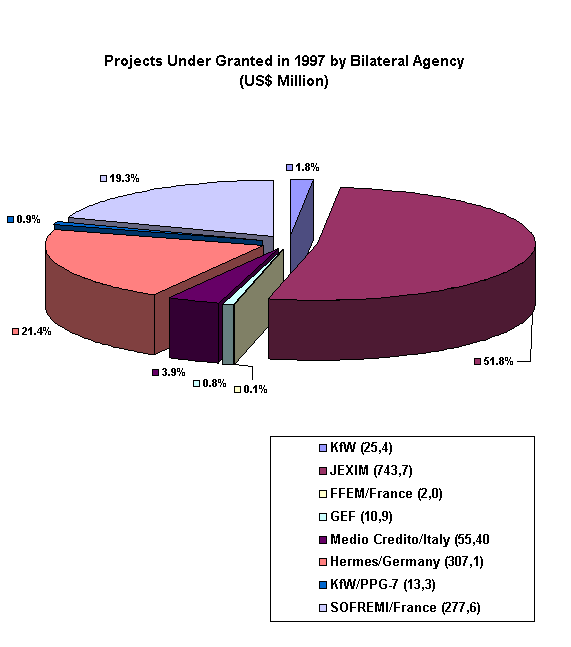
The most relevant aspect of the Brazil-Japan relationship during 1997 was the visit of the Ministry of Planning and Budget of Brazil to Tokyo by May. Several meetings were held at JEXIM, OECF, Gaimusho, EPA, MITI and Keidanren. The more remarkable results achieved were the signature of the Memorandum of Understanding and the reduction of mandatory banking reserves for loans to Brazil.
Continuing the process initiated in 1995, two missions of the EXIMBANK of Japan visited Brazil in 1997. Several meetings arranged by CGFIB were held at Brazilian Ministries as well as at the Central Bank and BNDES. The first mission was from the CRAD - Country Risk Analysis Department, which performed the macroeconomic assessment. Their findings were quite positive and ended up in a published report and in seminars on the Brazilian economy in Tokyo soon afterwards. The second mission was from the Loan Department III, aiming to analyze the List of Priority Projects to Brazil, identifying those already with JEXIM commitment, the ones waiting for approval for the following semester and those for which additional time to mature is requested. SEAIN/CGFIB, reflecting the priority given by Government as a whole, emphasized the need for funding for projects included in the so called "Brazil in Action".
Concerning to the bilateral relationship with German, a round o meetings on the financial and technical cooperation took place in Brasilia in July 1997. By the time, the German Government showed their willingness to allocate DM 50,0 million to allow the program PPG-7 to continue. The event also was useful for monitoring projects being executed and to talk about the pipeline of projects. The monitoring meetings on projects already approved by KfW by still to be signed by Brazil allowed to solve several and different pending issues in order to have the contracts signed as quickly as possible.
Due to reasons related to the Governmental budget, it was not possible by 1997 to implement the conjugate financing model previously requested by Brazil.
Regarding to environmental projects, Brazil ended in 1997 in the third position as recipient of GEF founds, just after China and India. In total, the country received US$ 96.84 million as donation. Such resources were directed to 16 projects, 2 of them already concluded.
As said above, the German Government announced their intention to contribute additionally with DM 50.0 million, that would be allocated as following:
- DM 10.0 million - Implementation and Management of Conservation Unit II.
- DM 15.0 million - Protection of Atlantic Forest.
- DM 15.0 million - Type A Demonstrative Projects
- DM 10.0 million - Recuperation of Desegregated Areas
During 1997 the main sources of funds available to PPG-7 continued to come from the KfW of Germany. Also, minor contributors continued to be the Rain Forest Trust Fund and the Commission of European Community.
By the end of 1997, the portfolio of projects followed-up by CGFIB reached the to total cost of US$ 6,959.3 million, with US$ 3,366.2 million from bilateral agencies (including US$ 281.0 million as donations). The figures represent an increase of 77.1% in the bilateral financing since 1995.
In 1997, the following projects were concluded:
- Multi-sector Credit Program of BNDES (JEXIM)
- Control of Industrial Pollution BNDES (JEXIM)
- Rural Electrification of Goiás State (JEXIM)
By the end of 1997 the total amount of bilateral financing and donations for environmental projects during the decade had the following configuration:
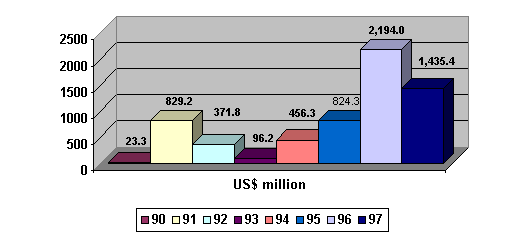
The total amount of projects under execution by that time was US$ 3,366.26 million, distributed according to the bilateral agencies as it follows:
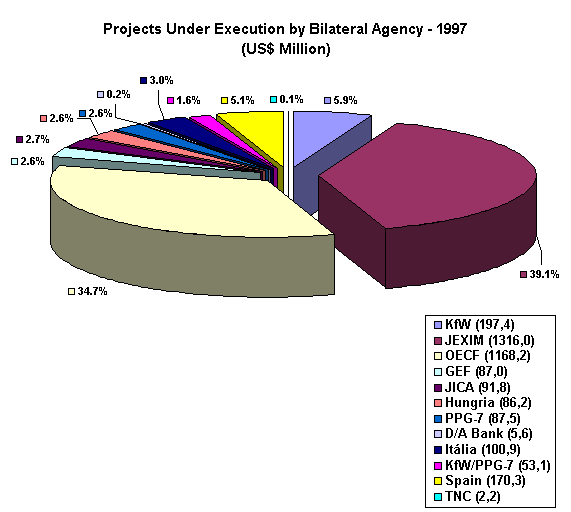
- ACTIVITIES IN 1998
SEAIN/CGFIB gave still more emphasis during 1998 for the monitoring of executing programs and projects. This was addressed through the monitoring meetings and also getting more involved to the monitoring missions promoted by the financing agencies.
Following the practice established by the Memorandum of Understanding, two monitoring meeting with EXIMBANK of Japan occurred in 1998. The first took place in Tokyo by the beginning of March, and last in Brasilia by November. In the two occasions, problems concerning to implementing projects were discussed as well as the dynamic priority list of projects was reviewed by both parts. During the visit of SEAIN/CGFIB to Tokyo by March, it was possible to include the Chief Economist of the Ministry of Planning in the mission, making possible to him to talk to several Japanese authorities about the Brazilian economy as well as about the Asian crisis.
Also with the KfW of Germany and OECF of Japan, the monitoring meetings occurred during 1998, promoting more effectiveness to the monitoring process.
The development of a new system to control the financing process, called GFIEX - "Sistema Integrado de Gestão de Financiamento Externo" , was also an important initiative conducted by 98. During the year, the experimental phase was carried out with the introduction of 26 approved "consulting-letters" into the system.
Another important event during 1998 was the announcement by OECF of the "pledge" for four relevant projects: Sanitation Program of São Luis Island, "Caatinga" Project, Pro-Water and PMSS-II. The respective negotiations are expected to occur in 1999.
Relatively to JICA, CGFIB acted hardly with other Brazilian governmental agencies and the Japanese counterparts trying to address all the pending issues concerning to PRODECER II. The program, designed to develop the "Cerrado" area in Brazil was signed in 1994 and over US$ 16 million, from the original amount of US$ 153.20 million, are still to be disbursed. Although the program has been considered successful from the point of view of achieving the expected results, some financial issues related to the final borrowers remain unsolved.
Besides the regular monitoring meeting with KfW, which once again showed to be an effective tool to deal also with projects already approved by the agency but still to be signed by the parts, SEAIN/CGFIB participated of the intergovernmental meeting on technical and financial cooperation between the two countries in Frankfurt by July 1998.
The agreement with the World Bank regarding to PPG-7, approved by the Federal Senate by 1993, fixed the total amount of US$ 250 million in external resources for the first phase of the program. By the end of 1998, US$ 204.4 million in projects had their preparation already authorized. The majority of such a resources were donated by Germany (US$ 109.9 million).
The pilot phase, which is represented by demonstrative projects, has been implemented, and the disbursements related to that reached US$ 44.3 million. Some projects have already reached more than 50% and are now being considered to be allowed to go to phase II.
Brazil paid US$ 3.8 million in 1998 as its contribution to the first phase of GEF (1991-94). As in 1994 GEF was redesigned, Brazil will need to make an additional contribution around US$ 4 million to be in position of participating in this second phase. Until the end of 1998, Brazil received from the fund US$ 106.80 million in donations, with 16 projects being granted so far.
The total amount of the bilateral financing in Brazil reached US$ 962.44 Million in 1998, divided as it follows:
- Contracts signed during the year: US$ 829.64 Million
- Contracts only negotiated during the year: US$ 132.80 Million
Bilateral Financing in 1998 – Signed Contracts (US$ Million)
|
Project |
Agency |
Total
Cost |
Bilateral
Financing |
|
Type "A" Demonstrative Project |
KfW/PPG-7 |
23.30 |
13.30 * |
|
PROMANEJO (in substitution to FLONAS) |
KfW/PPG-7 |
14.70 |
13.30 * |
|
Rural Electrification of Tocantins |
JEXIM |
100.00 |
68.70 |
|
North-South Transmission Line |
JEXIM |
936.00 |
300.00 |
|
Fernao Dias Highway II |
JEXIM |
550.00 |
180.00 |
|
Environmental Sanitation Project of Parana |
OECF |
390.80 |
234.50 |
|
National Strategy for Biological Diversity |
GEF |
1.48 |
0.94 * |
|
Thermal-Solar Power Generation |
GEF |
10.50 |
9.84 * |
|
Total |
|
2.026.78 |
829.64 |
(*) donation
Bilateral Financing in 1998 – Contracts only Negotiated (US$ Million)
|
Project |
Agency |
Total
Cost |
Bilateral
Financing |
|
Science and Technology Development Program - FINEP |
JEXIM |
120.00 |
120.00 |
|
Integrated Management of "Alto Rio Paraguai" Basin Phase II |
GEF |
14.65 |
6.55 |
|
Integrated Management of Water Resources of São Francisco River Basin Phase II |
GEF |
19.59 |
4.65 |
|
Small Projects Program Phase II |
GEF |
0.34 |
0.34 |
|
Water Management in Ships |
GEF |
1.20 |
1.20 |
|
Climate Awareness Program |
GEF |
0.06 |
0.06 |
|
Total |
|
155.84 |
132.80 |
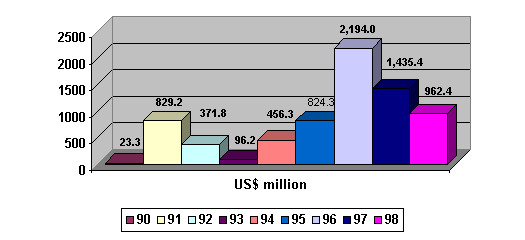 By the end of 1998 the total amount of bilateral financing and donations for environmental projects during the decade had the following configuration:
By the end of 1998 the total amount of bilateral financing and donations for environmental projects during the decade had the following configuration:
The total amount of projects under execution by that time was US$ 4,094.80 Million, distributed according to the bilateral agencies as it follows:
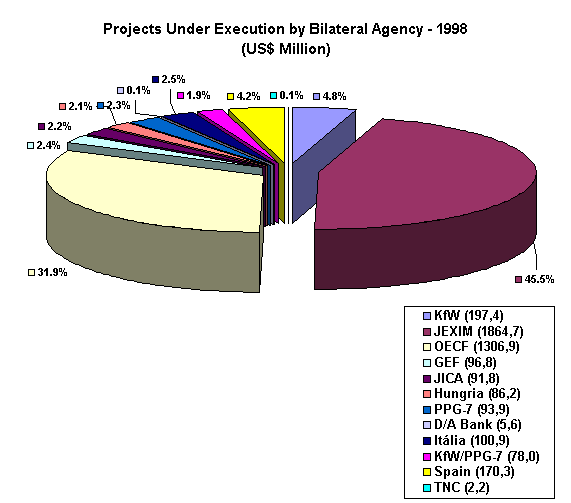
- PORTFOLIO OF PROJECTS
The following graphics shows the evolution of the total amount in US$ for the period 1995-98. The numbers express the amount being financed by bilateral agencies. Attachment 1 brings additional information such as the total cost of the project, co-financing, projects by agency and others related to the portfolio of projects as of December 1998.
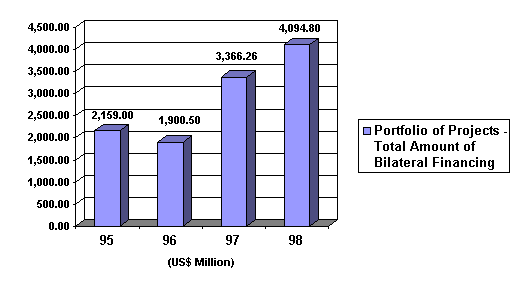
- DISBURSEMENTS (95-98)
During the reviewed period, the total disbursed amount by bilateral agencies was US$ 1,460.00 Million, distributed as it follows:
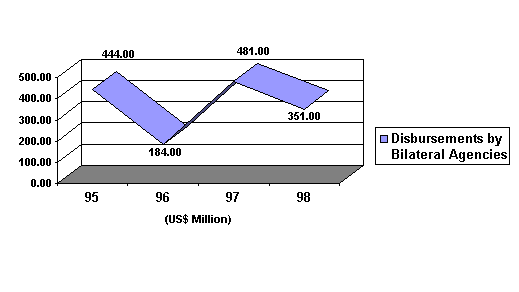
- PIPELINE OF PROJECTS: PROSPECTS
The "Program of Fiscal Adjustment" adopted by the Brazilian Government to fight the public deficit is expected to make harder to the States and Municipalities to take new external financing.
Also, the Privatization Program contributed to reduce the number of potential borrowers, since Government is not any more requested to make investments in some sectors.
The need for a narrow monitoring of the fiscal situation led to the creation of CCF - "Comissão de Controle e Gestão Fiscal" - Committee for Fiscal Management and Control, which will be also responsible for giving the final word on new external financing, even on those already approved by COFIEX (with few exceptions).
The emphasis will still be put upon projects included in the Governmental package called "Brasil em Ação". Besides, projects able to be granted with co-financing will also have considerable advantage, since the need for national counterpart will be reduced.
In total, SEAIN/CGFIB expect to rise US$ 1,800.00 Million from bilateral agencies in 1999. By OECF, 5 projects are expected to be granted in a total amount around US$ 452.5 Million. JEXIM is expected to provide up to US$ 1,300.0 Million in 1999 for 3 projects. The KfW of Germany is expected to provide US$ 33.2 Million (including US$ 22.4 as donation) for 3 projects during this year.
The pipeline of projects can be found as Attachments 2 and 3. Attachment 2 consists of the list of projects already approved by COFIEX, and Attachment 3 presents the list of projects not yet submitted to COFIEX approval.




 By the end of 1996 the total amount of bilateral financing and donations for environmental projects during the decade had the following configuration:
By the end of 1996 the total amount of bilateral financing and donations for environmental projects during the decade had the following configuration:



 By the end of 1998 the total amount of bilateral financing and donations for environmental projects during the decade had the following configuration:
By the end of 1998 the total amount of bilateral financing and donations for environmental projects during the decade had the following configuration:

